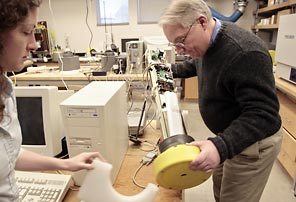|
University of Washington oceanographer Steve Riser, shown here with graduate student Alison Rogers, helped design the network of 3,000 Argo floats. About 850 floats were built at the UW. |
| Information Read more about Argo and the research it supports: www.argo.ucsd.edu |
When Steve Riser sends his research progeny out into the world, he knows he'll probably never see them again.
But they call home regularly.
"Here's one that just came up today, off Hawaii," the University of Washington oceanographer said, scrolling through a list on his computer. A mouse click reveals another one floating under the ice south of Australia. Dozens drift along the coast of Washington and Oregon.
Riser's babies are torpedo-shaped robots designed to measure ocean temperature, salinity and currents and beam the data back via satellite. Scattered around the globe, the probes are part of the first worldwide network to monitor the 70 percent of the planet covered with water.
"We've never had anything like this," said Riser, who along with his colleagues recently celebrated a milestone: deployment of their 3,000th robotic float.
That's the target the team set nearly a decade ago, when it first made its pitch that scientists need to know what's going on in the oceans in order to understand climate change. Even before the network called Argo was complete, it helped refine forecasts of global warming's likely impacts on sea level and patterns of drought.
"The Argo floats are creating a revolution in oceanography and our ability to do climate prediction," said Kevin Trenberth, head of climate analysis at the National Center for Atmospheric Research. "They must be kept going."
Riser and other members of Argo's steering team are fighting to ensure that the international collaboration doesn't unravel for lack of maintenance money.
"We have 3,000 floats now but you have to keep replacing them," Riser said. "This is only the beginning."
But it's a good position, considering skeptics said the project would never work.
It's not that anyone doubted the powerful role oceans play in global climate. Warm currents in the Atlantic keep England and northern Europe from being as frigid as the Canadian plains. When the equatorial Pacific heats up, the resulting El Niños can change weather patterns around the world.
As greenhouse gases from cars and power plants trap more heat in the atmosphere, the oceans which absorb much of that heat will largely determine which places will get rainier, which will dry out and how storm patterns will shift.
What worried skeptics was the technical difficulty in pulling off the $80 million plan. Previously, ocean monitoring was a laborious and costly job, requiring a research ship and crew to maintain the finicky instruments.
It was the development of compact, automated sensors capable of withstanding years of battering in the ocean that made Argo possible. The first buoys were deployed in 2000.
